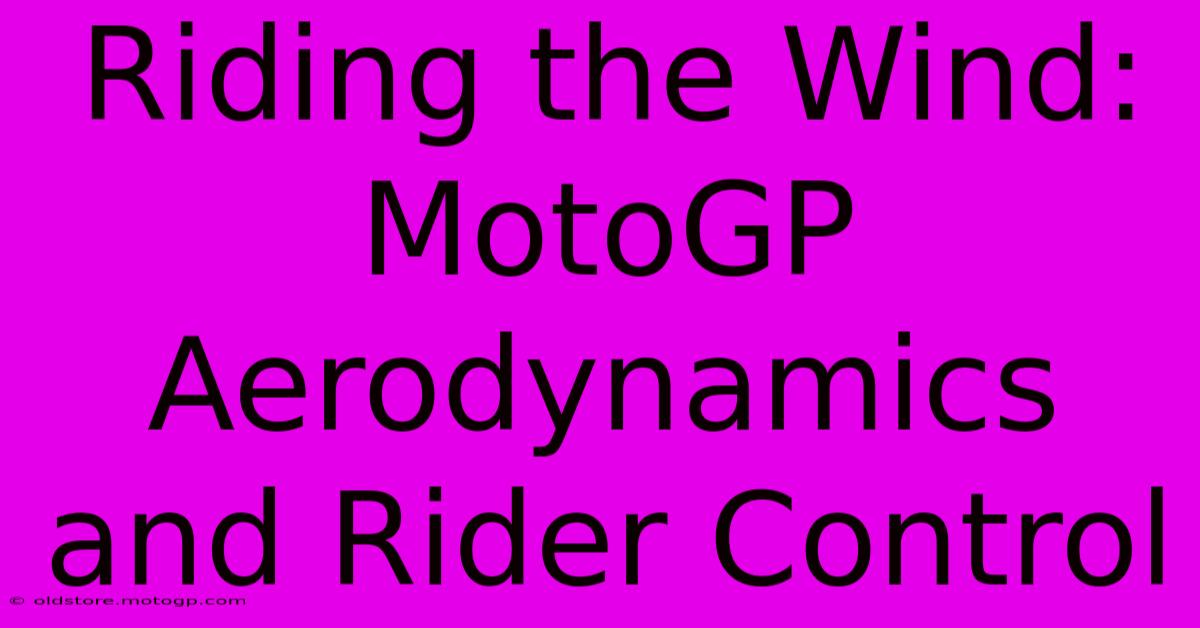Riding The Wind: MotoGP Aerodynamics And Rider Control

Table of Contents
Riding the Wind: MotoGP Aerodynamics and Rider Control
MotoGP, the pinnacle of motorcycle racing, isn't just about horsepower and skillful riding; it's a finely tuned dance between machine and man, heavily influenced by the often-overlooked science of aerodynamics. Understanding how aerodynamic forces impact rider control is crucial to appreciating the complexities of this exhilarating sport. This article delves into the intricate relationship between MotoGP aerodynamics and rider control, exploring how advancements in wing design and rider positioning contribute to lap times and race results.
The Aerodynamic Arms Race: Wings, Winglets, and More
Modern MotoGP bikes are sculpted masterpieces of aerodynamic engineering. Gone are the days of relatively simple fairings; today's machines boast an array of wings, winglets, and carefully designed bodywork, all aimed at maximizing downforce and minimizing drag. These aerodynamic aids are not mere aesthetic additions; they play a critical role in several key aspects:
Increased Downforce for Cornering Stability:
Downforce, the force pressing the bike towards the track, is paramount in high-speed cornering. Wings and winglets generate this downforce, allowing riders to lean into turns with greater confidence and maintain higher speeds through corners. This translates directly into faster lap times. The intricate design of these aerodynamic elements, including their angle of attack and surface area, is meticulously optimized through Computational Fluid Dynamics (CFD) simulations and wind tunnel testing.
Improved Front-End Stability:
Maintaining stability at the front end is vital for precise control. Aerodynamic elements contribute significantly to this stability, reducing the tendency for the front wheel to lift under acceleration or during braking. This enhanced stability allows for more aggressive riding styles and improved braking performance.
Reduced Wheelie and Drag:
While downforce is key, minimizing drag is equally important. The design of the fairing and aerodynamic appendages is optimized to reduce air resistance, allowing the bike to achieve higher top speeds and accelerate more quickly. Additionally, aerodynamic aids can help manage wheelies under hard acceleration, keeping the front wheel planted for better control.
Rider Control: The Human Element
While the bike's aerodynamics provide the foundation, rider control remains paramount. The rider must adapt their riding style and body position to effectively utilize the aerodynamic forces generated by the bike:
Body Positioning and Aerodynamic Balance:
The rider's posture significantly affects aerodynamic performance. Riders constantly adjust their body position – leaning, tucking, and shifting their weight – to manage the forces acting on the bike. This intricate interplay between rider input and aerodynamic forces is constantly refined during practice and race sessions.
Feel and Feedback:
Experienced MotoGP riders possess an exceptional feel for the bike’s behavior, allowing them to anticipate shifts in aerodynamic forces and adjust their riding style accordingly. This sensitivity allows them to push the limits of grip and maintain control even when battling strong crosswinds or navigating challenging track sections.
Adapting to Changing Conditions:
Track conditions, such as temperature and wind speed, can significantly affect aerodynamic performance. Riders must adapt their riding style and sometimes even make adjustments to bike setup to account for these varying conditions.
The Future of MotoGP Aerodynamics
The ongoing development of aerodynamic technologies in MotoGP is relentless. We can expect to see further refinements in wing design, potentially leading to even greater levels of downforce and improved stability. The integration of advanced materials and manufacturing techniques will also continue to play a crucial role in enhancing aerodynamic performance and rider control.
In Conclusion:
The combination of sophisticated aerodynamic design and exceptional rider skill defines the cutting edge of MotoGP. The aerodynamic forces acting on the bike are not merely passive influences; they are actively managed and exploited by the rider to achieve ultimate performance. Understanding this intricate relationship is key to appreciating the breathtaking skill and technological marvel that is modern MotoGP racing.

Thank you for visiting our website wich cover about Riding The Wind: MotoGP Aerodynamics And Rider Control. We hope the information provided has been useful to you. Feel free to contact us if you have any questions or need further assistance. See you next time and dont miss to bookmark.
Featured Posts
-
Moto2 Bikes The Choice Of Champions
Feb 25, 2025
-
Cota Gifts For The Ultimate Cota Fan
Feb 25, 2025
-
Moto2 Standings 2025 Who Will Reign Supreme
Feb 25, 2025
-
Cota Grounds Pass Live The Experience
Feb 25, 2025
-
Moto Gp The Art Of Speed And Control
Feb 25, 2025
